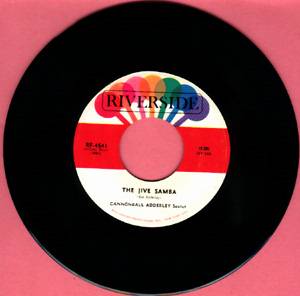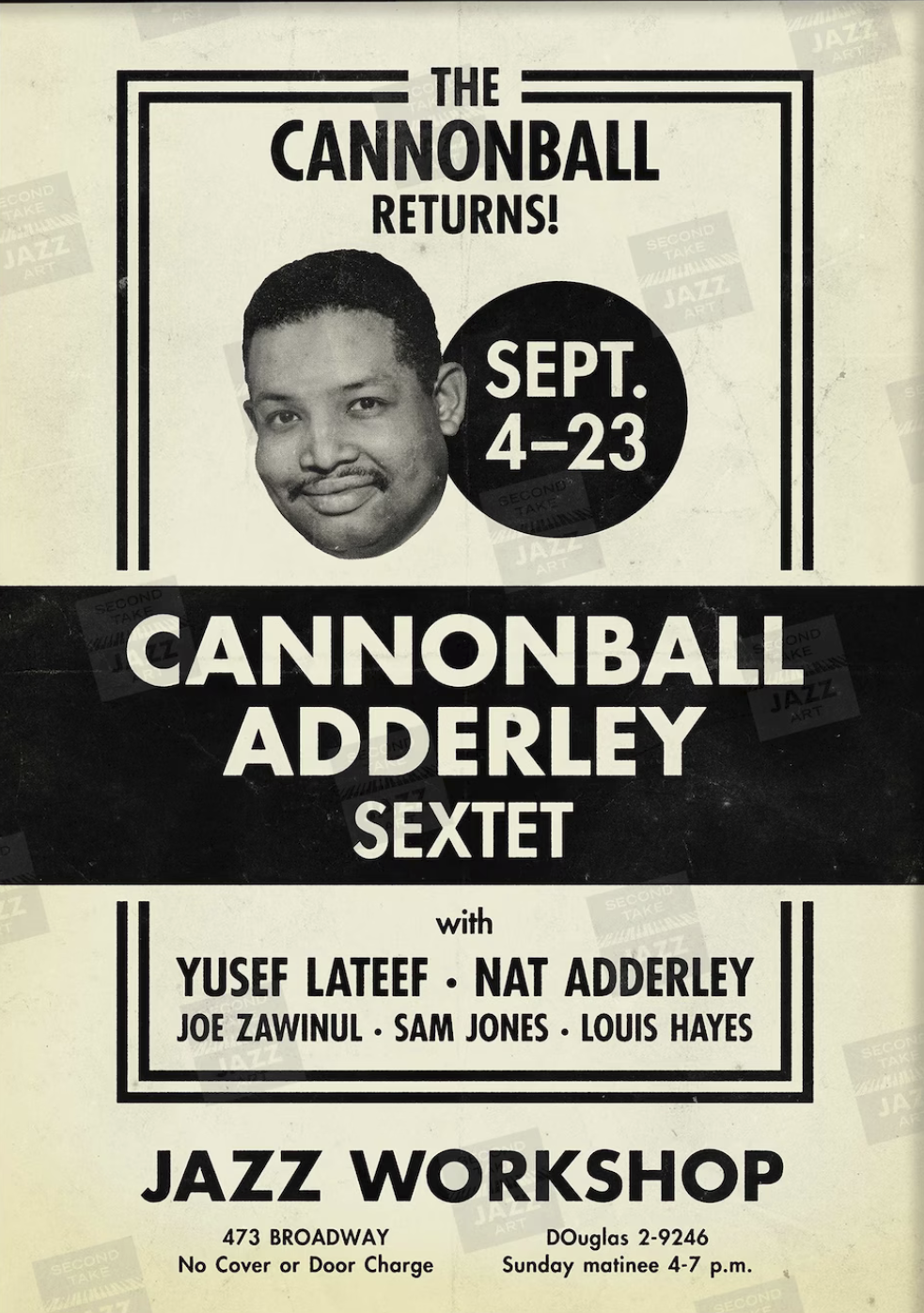|
|
| Discography |
| About Julian |
| About Site |
Since Dec,01,1998
1998 By barybary

![]()
|
"THE JAZZ WORKSHOP REVISITED" |
![]()
 |
the Original LP cover
and the HIT Single 45 rpm "Jive Samba"
 |
Other Reissue

JULIAN "CANNONBALL" ADDERLEY, alto sax;
NAT ADDERLEY, cornet;
YUSEF LATEEF, flute and tenor sax;
JOE ZAWINUL, piano;
SAM JONES, bass;
LOUIS HAYES, drums.
|
Recorded "live" at The Jazz Workshop , San Francisco, September 22 & 23 , 1962 |
SIDE 1
An opening comment or two by Cannonball ...
1. Primitivo (9:13)(Julian
Adderley) (BMI)
2. Jessica's Birthday (6:31) (Quincy Jones) (ASCAP)
3. Marney (6:55)(Donald Byrd) (BMI)
SIDE 2
Another few words...
1. The Jive Samba (11:02)(Nat
Adderley) (BMI)
2. Lillie (4:44)(Sam Jones) (BMI)
3. Mellow Buno (5:52)(Yusef Latee/) (BMI)
Time to go now... really!
N.B.on the reissue Produced by
Orrin Keepnews
in 1985 , Landmark LLP1303
a Bonus tracks was added : "Unit
Seven" (Sam Jones ) 9:19 and "Lillie"
was deleted
|
Here we are again with Cannonball and associates in The Jazz Workshop . . and it sounds like a very good place to be. Which is exactly the way it sounded while this warm and happy album was being recorded before a warm and happy, no-empty-seats audience. A great many thousands of listeners must feel very much at home in this setting even though most of them may never even have set foot in the city of San Francisco. For the Workshop, one of the best-known and most relaxed of the nation's jazz nightspots, was of course also the scene of the Adderley's group's very first LP: the remarkable, phenomenally best-selling "Cannonball Adderley Quintet in San Francisco," which helped catapult this band to the top and has become something of a landmark among on-the-job jazz records. The idea of again capturing the band in action in this room is one that, naturally enough, all concerned have had in mind for quite some time. It wasn't just a matter of wanting to return to the scene of the band's initial triumph - although the club will always have a special sentimental value, something like a good-luck charm, for Cannonball and for Riverside. It was also a matter of a long-standing awareness that this is a band that responds magnificently to the stimulus of the right crowd. And, with no offense intended to any other place or people, it has been my experience that audiences in San Francisco in general and at The Jazz Workshop in particular are just about the rightest crowds possible! The group has of course been back several times since that momentous first engagement in 1959. But it wasn't until roughly the third anniversary of that occasion that all the circumstance fell into place to bring about the present album. And although this is not and could not be intended as an 'duplication" of the earlier LP, there are some rather remarkable similarities to be noted. For one thing, no less than four members of the original quintet are still very much on hand: the Adderley brothers themselves, and the unbeatable rhythm team of Sam Jones and Lou Hayes. (In jazz today, such band longevity is in itself something special.) The only changes are that Joe Zawinul, from Austria, has for some time been on piano, and that the group has been augmented to sextet size by the addition of the deep-toned tenor sax and vivid flute of Yusef Lateef. For another thing, there is the inclusion of what seems clearly destined to be another of those rare, all-pervading tunes. The first album had, (do we need to remind anyone?) Bobby Timmons' memorable This Here. Other LPs have introduced other stand-outs (several of which have been assembled on "Cannonball's Greatest Hits"). Now we have Nat Adderley's richly low-down Jive Samba. There was no difficulty in spotting this one: the first time I heard it, and heard the reaction it provoked (such as you can hear on the record), it was obvious that this tune had what it takes. Which was no more than what the band had been telling me since I arrived in town. And even before the release of this album, a short 45-rpm single version of The Jive Samba (extracted from this recording) had sky-rocketed into nation-wide "hit" status. The very mean Samba is scarcely alone here. There is Cannon's thoroughly unique and gripping Primitivo; Lateef's swinging, Ellington. tinged Mellow Buno; and Sam Jones' very pretty ballad, Lillie - a total of four quite varied examples of the composing talents of this group. Plus a wonderfully buoyant treatment of a Quincy Jones tune, and an intriguing, adventurous new number contributed by Donald Byrd. Small wonder that, after a night of music like this, the audience gave Cannonball a hard time about leaving the stand (as reported at the end of Side 2). Fortunately, however, there is no curfew hour for recorded club dates. All you have to do is to start listening all over again, from the top. - ORRIN KEEPNEWS
|

